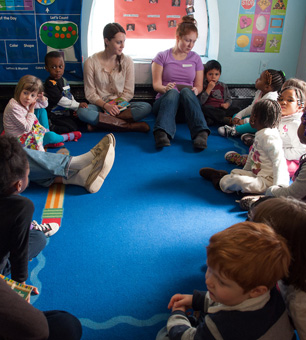It’s been awhile, but it looks like U.S. schools are finally doing something right. According to the 2012 National Assessment of Educational Progress (NAEP) — also known as “The Nation’s Report Card” — minority students are making gains and shrinking the learning gap between them and white students.
The improvement in scores is all the more notable as English-language learners and students with disabilities are now being included, as Peggy Carr, the head of testing for the Education Department’s National Center for Education Statistics, notes to USA Today. About 50,000 students take assessments in reading and mathematics at the ages of 9, 13 and 17.
The Department of Education first began to track reading in 1971. Based on the results of testing from 2011- 2012, African-American 9-year-olds have decreased the reading gap with white students from 44 points to 23 points, scoring 206 on a 500-point scale in 2012; the average score for white students was 229.
Hispanic students have lessened the gap between them and white students from 34 points to 21 points — their score was 208 –since 1975 when the Department of Education started tracking their scores.
As Washington D.C.-based Education Trust, which advocates for low-income and minority students, says, the latest NAEP results “put to rest any notion that our schools are getting worse.”
What Should We Do To Maintain These Gains?
The latest statistics show great gains among students. But we need to keep in mind that the scores minority students receive now were those of white students in 1971. In addition, the gains in testing scores for reading were not seen in older students. 13-year-olds scored higher in both reading and mathematics than students in their groups in the 1970s. But 17-year-olds showed no change in their scores in reading and math, though the lowest-performing did improve their scores.
The Education Trust points out that education in the U.S. is not moving fast enough to keep up with changing demographics. In 1978, 80 percent of U.S. students were white; 13 percent were black, 6 percent were Hispanic and 1 percent were Asian. But in 2012, 56 percent of students were white, while 15 percent were black, 21 percent were Hispanic and 6 percent were Asian. The U.S. Census Bureau predicts that, by 2020, more than half of Americans under 18 will belong to a racial or ethnic minority group. Already in Texas, the majority of students are from what can really not be called “minority” groups anymore.
The Education Trust emphasizes that we need to keep doing what have been to keep reducing the learning gap rather than seeing it widen again. We must keep schools accountable for students’ academic performance, provide a “rich curriculum” and quality teaching teachers. We also need to keep funding public schools, especially in lower-economic districts. And, of course, we really need to target issues like disproportionately higher rates of suspension and expulsion for African-American and Hispanic students and look into issues like special education, which minorities are overrepresented in. Are too many minority students receiving a label of, for example, ‘behavior problems,” rather than something like an autism spectrum disorder diagnosis?
One final point made in the report regards readings for pleasure. At age 9, 53 percent of students say they read for fun at home almost every day. However, by age 13, only 27 percent did, and at the age of 17, only 19 percent still read for pleasure at home. Notably, while the number of 9-year-olds who report reading for fun has stayed the same since 1984 (when the question was first asked), it has decreased over time for 13- and 17-year-olds.
As the NAEP comments, “at all three ages, students who reported reading for fun almost daily or once or twice a week scored higher than did students who reported reading for fun a few times a year or less.” Even if it’s not to raise test scores, it certainly does help to read a book.
Now the question is, in the digital age that we live in, how can we motivate students to continue to read as one way to help them maintain the educational gains they’ve been making — and even improve on them?
Join us in defending the truth before it’s too late
The future of independent journalism is uncertain, and the consequences of losing it are too grave to ignore. To ensure Truthout remains safe, strong, and free, we need to raise $47,000 in the next 8 days. Every dollar raised goes directly toward the costs of producing news you can trust.
Please give what you can — because by supporting us with a tax-deductible donation, you’re not just preserving a source of news, you’re helping to safeguard what’s left of our democracy.
